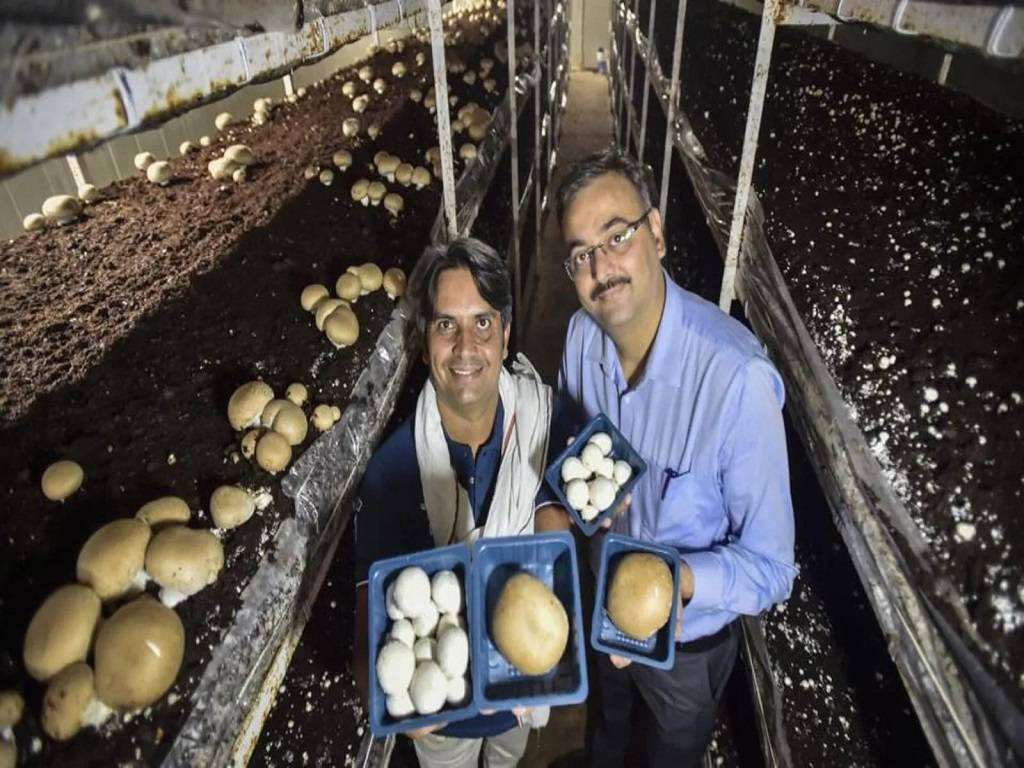
It's a hot June day outside, with a temperature of 42°C, but inside the Rameshwar Mushroom Farm's 'growing room,' it's gloomy and the temperature is a pleasant 15°C. The chamber, with its endless rows of iron beds, resembles a gigantic dormitory. White button mushroom pinheads may be seen emerging through the casing soil on the beds.
"We produce over 200 tonnes of white button and portobello mushrooms throughout the year," says Amit Bhatnagar, managing partner of Rameshwar Mushroom Farm in Tatesar village, roughly 40 km from Connaught Place, one of Delhi's largest environment-controlled mushroom farms.
Over a hundred mushroom farms have sprouted in Delhi-NCR in the last two years of the epidemic, particularly in the Najafgarh, Bawana, and Bakhtawar regions of outside Delhi. While the majority of these farms are seasonal, growing mushrooms in bamboo and thatch rooms from September to March, there are over two dozen others, such as Bhatnagar's, that nurture the fungus all year.
Surprisingly, many of the farms' owners are not simply local farmers, but also young entrepreneurs from all across Delhi. Not just farming, but mushroom growing training workshops given by individuals and agriculture institutes around Delhi and the NCR are also popular.
"Since Covid - 19, there has been a large demand for mushrooms on the market, and many people believe it's a successful business," says Rakesh Kumar, a partner at Rameshwar Mushroom Farm, who left his job as a network engineer at a multinational to pursue farming.
"Button mushrooms account for 97% of our output, while portobello mushrooms account for the remaining 3%. We sell roughly 80% of our goods to vegetable and fruit aggregators and the balance to the Azadpur Sabzi Mandi," Bhatnagar explains.
Button mushrooms account for almost 95% of all mushroom cultivation in Delhi, with portobello, milky, and oyster mushrooms accounting for the remainder. The majority of mushrooms in Delhi are seasonal. While button and portobello mushrooms are cultivated in the winter, milky and oyster mushrooms are harvested in the summer.
Rising demand for training
Narendra Dagar, a seasonal mushroom farmer in Dhansa village, Najafgarh, has been busy instructing city slickers in mushroom growing for the past two years. His trainees come from Gurugram, Delhi, Noida, and other regions of the nation, he claims.
At his Victory Mushroom Farm and Training Centre, he claims to have trained almost 200 people. Farmers who want to transition from traditional farming to mushroom farming, people who lost their jobs during the epidemic and are seeking for a new way to make money, and young entrepreneurs from all around Delhi are among them. "The demand for training is so great these days that I'm focusing more on instruction than mushroom farming," adds Dagar, who costs ₹2,000 for a day's basic mushroom cultivation training.
A boon for small farmers
Seasonal mushroom farming, according to Pappan Singh Gehlot of Tigipur village in north-west Delhi, possibly the capital's oldest mushroom grower, may be a windfall for farmers with tiny land holdings. Between September and March of each year, he produces roughly 60 tonnes of button mushrooms in 20 bamboo and thatch huts on 2 acres of land, employing about 55 people.
A bamboo house costs around $30,000 to build, compared to a climate-controlled puf panel mushroom growing room, which costs anywhere from ₹15 to ₹25 lakh depending on size.
"During the season, the average cost of manufacturing one kilo of white button mushroom is Rs50, and the mushrooms can be sold for up to ₹130 per kg, depending on the quality of the mushrooms and mandi prices." In the worst-case situation, one may easily make $30 per kilogram of mushrooms on average," adds Gehlot, who came to fame in May 2020 after flying ten of his employees to Bihar during the shutdown.
Farmers can earn up to ₹12 lakh from one acre
"While growing wheat on one acre is unlikely to provide more than ₹40,000 in profit, producing mushrooms on one acre can easily yield returns of ₹10 lakh to ₹12 lakh." Besides, mushroom growing is significantly more labour-intensive than typical farming and requires far more people," he adds.
The economics of environment–controlled farms, however, operate differently, according to Rakesh Kumar of Rameshwar Mushroom Farm, because their production costs are substantially greater. "It costs us about ₹95 to produce one kilogram of mushrooms, including the cost of energy, transportation, and packing, which varies during the year. Because of oversupply, the market rate for button mushrooms in the summer last year was ₹160 a kg; this year, it is only ₹110. However, as more people become aware of the health advantages of mushrooms, we anticipate an increase in demand."











